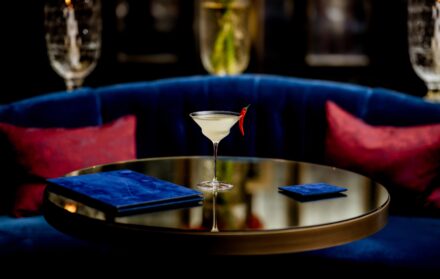
Maximilian Riedel: Farewell To Champagne Flutes
Maximilian Riedel is a hard man to pin down. Currently travelling the world extolling the virtues of Champagne, we managed to have a few words with the glassware guru and his UK managing director Steve McGraw,
The war on the Champagne flute
When Maximilian was 18 years old, he worked as a summer tour guide in Champagne. What he observed was that ‘true lovers’ of Champagne would choose to drink from wine glasses, rather than the narrow, straight-sided flute. Since that fateful day, he has worked to develop the Champagne wine glass.
“Champagne is a wine and deserves to be treated as such. Whether enjoying a Blanc de Blanc or a Cuvée, the Champagne wine glass allows the wide range of aromas of Champagne to unfold,” explains Maximilian Riedel. “The larger rim diameter enables the scent of the Champagne to be released, in a way which is not possible with a narrow flute. The glass also includes a ‘sparkling point’ to aid the formation of the Champagne bubbles – effervescence being an important part of the Champagne experience.”

The glass makes all the difference
The entire sensory experience – from where on the tongue’s palate the liquid is guided, to how aroma is guided to our nose and our visual perception of a drink – is controlled by the glass.
“When we design a glass, it always involves a sensory workshop with the aim of presenting the beverage to our senses; smell, taste, touch, and sight – in a way which enhances the experience. A glass should be to wine as a speaker is to music – it should present every subtle element and nuance, every detail, in the best way possible. At Riedel we essentially make tools which enable enjoyment.” Steve McGraw
It’s hard work
Maximilian and his father travel the world to vineyards and wineries around the globe, working with the experienced tasters and wine producers renowned for producing wine from a specific variety of grape. A long process of tastings and test workshops are then conducted in order to develop a glass shape to enhance the taste and aroma of that grape. Riedel considers its glasses to be ‘wine tools’, allowing owners to unlock the most elusive characteristics of the wine they are drinking. All are created following the Bauhaus principle of ‘form follows function’.

A family matter
Maximilian is the 11th generation CEO and President of Riedel and the family’s history is inextricably intertwined with the heritage of the company.
Its HQ is in the stunning Austrian town of Kufstein, Tyrol. Kufstein as a location symbolises a fresh start for the Riedel family. After World War II the Communist government seized the family’s property, meaning the entire estate in Bohemia – all the glassworks and private assets – were gone.
2017 marks the 60-year jubilee of the Kufstein glass factory of Riedel Glas. Riedel has unveiled a permanent exhibition, titled ‘Glass Cabinet – Retrospective and Think Tank’, that presents the designs created in Kufstein over the past 60 years.
“This exhibition is a retrospective, a homage to the great achievements of my family’s past generations. But at the same time, the Glass Cabinet serves as a think tank for future designs – it provides both inspiration and motivation. For me, its message is: never stand still, always look for new paths and explore how my ancestors also managed to do just that.” Maximilian Riedel








